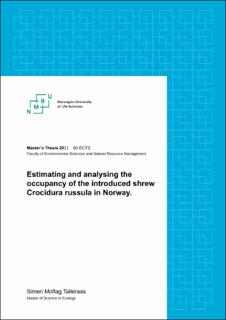| dc.description.abstract | The Greater white-toothed shrew (Crocidura russula) is a shrew that was discovered in Norway in 2017. The species is of concern because it is invasive and has a history of environmental impact. It is native around the Mediterranean Sea and in Continental Western Europe. It was discovered in Ireland in 2008, with a subsequent decline in the only native shrew. To study the spatial distribution of the species in Norway, fieldwork was conducted in the Stavanger region in 2019. The field survey consisted of camera trapping, pitfall traps, and confirmed reports from local citizens. Crocidura russula was discovered in 19 of 83 camera trapping stations, with an occupancy probability of 0.248 (CI = 0.248 - 0.404). The occupancy probability was similar to the native species Microtus agrestis, Sorex araneus, and Sorex minutus. The detection probability estimate was the highest of all species observed. Several covariates were tested to explain variation in occupancy. In the best model detection probability significantly decreased with increasing solar altitude, and increased with increasing proportion of artificial, open, and forest habitat. In the top ranked occupancy model human population had a positive effect, while the amount of forest at the landscape level negatively affected occupancy. The results had a large degree of uncertainty, and no predictor significantly predicted occupancy probability for Crocidura russula. There was also no support for a suspected point source at Stavanger port. No negative impact of Crocidura russula was found in this study, but this may be due to the limited sample size. More research is needed to assess how and whether Crocidura russula is expanding, and increased sample area and multi-season sampling should be a priority. | en_US |

